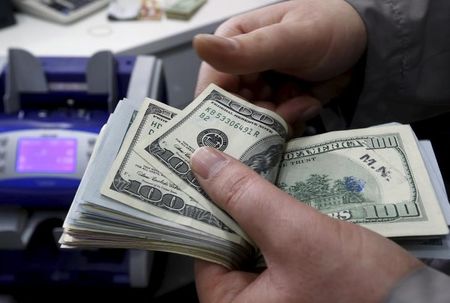
Investing.com – The U.S. dollar rose Wednesday, with the safe haven adding to the previous session’s sharp gains as an Iranian missile attack on Israel escalated tensions in the volatile region.
At 03:45 ET (07:45 GMT), the Dollar Index, which tracks the greenback against a basket of six other currencies, traded 0.1% higher to 100.969, after gaining about 0.5% in the previous session, its largest rise since Sept. 25.
Safe haven dollar rises
The turmoil in the Middle East escalated overnight with Iran launching a salvo of ballistic missiles on Israel in retaliation for its recent killing of Iran-backed Hezbollah leader Hassan Nasrallah and Israel’s deployment of ground forces into south Lebanon.
Iran has said its attack is over, barring further provocation, but Israel vowed a response, potentially dragging the United States, its backer, into the turmoil.
“Escalation in the Middle East has led [to] markets pricing in a greater risk of a fully-fledged conflict in the region, which could potentially involve the US,” said analysts at ING, in a note.
The dollar had also received a boost on Tuesday from a stronger-than-expected reading on U.S. job openings, especially ahead of Friday’s widely-watched official monthly jobs report.
“While the ISM manufacturing was a bit softer than expected and prices paid dropped below 50.0, the Fed is laser-focused on the jobs market, and the surprise rebound in job openings for August is contributing to a bullish short-term case for the dollar,” ING added.
Wednesday’s key economic release will be the ADP nonfarm employment number for September.
Euro stabilizes after selloff
In Europe, EUR/USD traded largely flat at 1.1067, following its largest drop in nearly four months on Tuesday, in the wake of further signs of cooling inflation in the eurozone.
The region’s inflation rate fell below the European Central Bank’s 2.0% target in September, and traders will look to comments from a host of ECB speakers, including Vice President Luis de Guindos and chief economist Philip Lane, for more guidance of future ECB monetary policy.
Citigroup said, in a note released on Tuesday, that it now expects the ECB to cut interest rates by 25 basis points in its Oct. 17 meeting, and expects subsequent cuts in December and through the start of 2025 to take the policy rate to 1.5% by September 2025.
GBP/USD traded 0.1% higher to 1.3293, considerably below last week’s high of 1.3430, a level not seen since February 2022, with this week being a quiet one on the UK economic data calendar.
Yen retreats on interest rate uncertainty
USD/JPY rose 0.3% to 144.06, after Japan’s newly appointed economy minister, Ryosei Akazawa, said on Wednesday that Prime Minister Shigeru Ishiba expects the Bank of Japan to make careful economic assessments when raising interest rates again.
The minutes of the Bank of Japan’s July meeting, released earlier this week, also showed that policymakers were divided on how quickly the central bank should raise interest rates further.
USD/CNY edged higher to 7.0185, with trading in the yuan quiet with Chinese markets now closed until Tuesday next week as the country celebrates Golden Week.
This post is originally published on INVESTING.



